
The Peregrine Falcon is a true marvel of nature, often regarded as the fastest bird on the planet. Imagine a feathered rocket, diving from the skies at speeds that can reach over 240 miles per hour! These incredible birds are not just celebrated for their speed; they possess a striking appearance and remarkable hunting skills that make them one of the most fascinating predators in the avian world. With their sleek bodies and distinctive blue-gray feathers, they are often seen soaring high above urban landscapes and rugged terrains alike.
You might be wondering what makes the Peregrine Falcon so special beyond their breathtaking speed. They have a unique hunting strategy that relies on surprise and precision. Instead of chasing their prey in a long, drawn-out pursuit, they perform breathtaking dives called stoops, where they plummet towards their target, using gravity to their advantage. It’s like watching a master archer take aim, only in this case, the arrows are birds—often unsuspecting ones. This hunting technique not only showcases their skill but also helps them capture prey that might otherwise escape.
Physical Characteristics
The physical characteristics of the Peregrine Falcon are as impressive as their abilities. Adults typically measure about 15 to 20 inches in length with a wingspan that can reach up to 3.5 feet. They display sexual dimorphism, meaning females are generally larger than males—sometimes weighing as much as 3.5 pounds compared to the male’s 2 pounds. This size difference is similar to how lions exhibit more size variation between genders, where the female lion is also smaller.
One of their most distinctive features is the dark “moustache” markings on their faces that contrast sharply against their pale cheeks. This gives them a fierce appearance that matches their reputation as skilled hunters. Their sharp, hooked beaks are perfectly designed for tearing into their prey. Additionally, their powerful talons are essential tools for grasping and immobilizing their catch, similar to a bear’s claws but finely tuned for flight.
Habitat and Range
Peregrine Falcons are found on every continent except Antarctica, showcasing their incredible adaptability. You can spot them in a variety of habitats, from coastal cliffs to urban skyscrapers. They often prefer open spaces where they can hunt effectively, so you might see them soaring over fields or perched on high points, scouting for food. Urban environments have surprisingly become one of their preferred habitats due to the abundance of pigeons and other city-dwelling birds, which serve as a plentiful food source.
Interestingly, Peregrine Falcons have a strong affinity for nesting in high, inaccessible areas. Traditional breeding sites include ledges on cliffs or tall structures, which provide safety from ground predators. This is much like how some animals, like mountain goats, choose elevated locations to avoid danger. As cities grow, Falcons have taken to nesting on buildings or bridges, adapting their behaviors to thrive in new environments.
Diet and Hunting Behavior
The diet of the Peregrine Falcon primarily consists of other birds, and they are particularly fond of pigeons, doves, and songbirds. Occasionally, they might venture to catch small mammals or reptiles, but birds make up the bulk of their meals. Think of them as selective hunters, like a gourmet chef choosing only the finest ingredients for a masterpiece. Their exceptional eyesight allows them to spot potential prey from great heights, making them formidable aerial predators.
Their hunting strategy is nothing short of spectacular. When a Peregrine Falcon sights its target, it ascends high into the sky before diving down at incredible speeds. This form of hunting, known as the stoop, is like a high-stakes game of aerial tag. The Falcon focuses all its energy on the prey, using its powerful muscles and wings to control the descent. As they approach their target, their feet extend, ready to snatch their meal mid-air. It’s a breathtaking performance of speed and agility!
Reproduction and Lifespan
Peregrine Falcons typically mate for life, showcasing a strong bond that lasts through the seasons. Courtship includes fascinating aerial displays where both partners perform acrobatic feats in the sky, which is almost like a synchronized dance. Nesting usually occurs in late winter or early spring. They prefer to lay their eggs on high ledges that offer protection from predators—much like how a parent would build a secure home for their young.
The female typically lays 3 to 5 eggs, which are incubated for about 29 to 32 days. After hatching, the chicks are helpless and depend entirely on their parents for food and care. Over the next few weeks, they grow rapidly and begin to fledge, a process where they learn to fly. It usually takes around six weeks for them to become proficient in flight. The lifespan of a Peregrine Falcon in the wild can range from 10 to 15 years, but some have been known to live even longer with proper conditions and care.
Conservation Status
The Peregrine Falcon faced severe population declines in the mid-20th century due to pesticide use, particularly DDT. This toxic chemical caused eggshell thinning, leading to reproductive failures. However, a vital conservation effort began in the 1970s, focusing on banning harmful pesticides and creating breeding programs. This is a classic case of people coming together to protect a species that once teetered on the brink of extinction, much like the efforts to save the bald eagle in the United States.
Thanks to these efforts, Peregrine Falcons are no longer listed as endangered. They have made a remarkable recovery, thriving in urban environments and even returning to some of their previously occupied habitats. However, threats like habitat destruction and climate change still pose risks. It’s a reminder of how our actions can have lasting impacts on wildlife and the importance of ongoing conservation work.
Table of Interesting Facts
| Common Name: | Peregrine Falcon |
| Scientific Name: | Falco peregrinus |
| Wingspan: | 3.3 to 3.6 feet |
| Top Speed: | 240 mph (386 km/h) |
| Diet: | Primarily birds |
| Average Lifespan: | 10 to 15 years |
| Habitat: | Urban areas, cliffs, and mountains |
Fun Facts About the Peregrine Falcon
As we delve deeper into the world of the Peregrine Falcon, you’ll find fascinating tidbits that highlight their uniqueness. For starters, did you know that these birds are capable of seeing ultraviolet light? This ability helps them to spot urine trails of their prey, leading them directly to potential meals. It’s like having a built-in GPS for hunting!
Peregrine Falcons are also known for their incredible adaptability. From nesting on cliffs to embracing cityscapes, they can thrive in diverse environments. They have even been spotted diving towards their prey at speeds so fast that they can create sonic booms—similar to the sound of a jet breaking the sound barrier! This adds an extra layer of awe to their already impressive hunting techniques.
The Peregrine Falcon is a true wonder of the animal kingdom, demonstrating resilience and adaptability in the face of challenges. Their breathtaking speed, remarkable hunting skills, and impressive recovery story make them a symbol of conservation success. Whether you’re watching them glide through the sky or learning more about their fascinating lives, it’s clear that these birds have earned their place as one of nature’s most extraordinary aviators.
FAQ
What is the Peregrine Falcon’s primary habitat?
The Peregrine Falcon is incredibly versatile regarding habitat. They thrive in a range of environments, including coastal cliffs, mountain regions, and urban areas. Their preference for nesting high up enables them to protect themselves from many land predators, leading them to select tall buildings and bridges in cities. This adaptability has allowed them to flourish in various settings, blending well into both natural cliffs and man-made structures.
How fast can a Peregrine Falcon fly?
The Peregrine Falcon holds the title for the fastest bird and can reach astonishing speeds of over 240 miles per hour during hunting dives, known as stoops. When they’re not diving, they can fly at speeds of around 40 to 60 miles per hour. This incredible speed helps them catch prey like pigeons and doves, making them superb aerial predators.
What does a Peregrine Falcon eat?
The diet of the Peregrine Falcon primarily consists of birds, such as pigeons, songbirds, and doves. They are expert hunters and prefer to catch their prey mid-flight. Occasionally, they may also catch small mammals or reptiles, but birds account for the majority of their diet. Their incredible eyesight is crucial in spotting prey from great heights.
Are Peregrine Falcons endangered?
While Peregrine Falcons faced significant population declines in the mid-20th century due to pesticides like DDT, they have made a remarkable recovery thanks to conservation efforts. They are no longer considered endangered and have successfully returned to many areas where they had previously disappeared. However, ongoing threats such as habitat loss and climate change still affect their populations.
Do Peregrine Falcons migrate?
Yes, some populations of Peregrine Falcons do migrate. Those that breed in the northern regions, such as Canada and Alaska, typically migrate south during the winter months to find milder climates and more abundant food sources. However, many urban-dwelling Peregrine Falcons remain in their cities year-round, taking advantage of the available food supply.
How do Peregrine Falcons catch their prey?
Peregrine Falcons use a hunting method known as stooping, where they fly high above their prey and then dive down at incredible speeds. This technique allows them to surprise their target and capture it mid-air. Their keen eyesight and powerful talons make them highly effective hunters, allowing them to catch fast-flying birds before they even realize what’s happening.
What is the color of a Peregrine Falcon’s eggs?
Peregrine Falcon eggs are typically a creamy white or light tan color with brown speckling. They usually lay between three to five eggs, which both parents take turns incubating. The eggs hatch after around 29 to 32 days, and the chicks rely on their parents for food and protection during their initial weeks of life.
Can Peregrine Falcons adapt to urban environments?
Absolutely! Peregrine Falcons have shown an impressive ability to adapt to urban environments. They often nest on tall buildings and bridges, taking advantage of the abundance of pigeons and other birds found in cities. This remarkable adaptability has helped their populations recover significantly and thrive in places where they might not have been found in the past.
How long do Peregrine Falcons live?
The lifespan of a Peregrine Falcon can vary but typically ranges from 10 to 15 years in the wild. Some individuals may live longer, especially if they are in protected areas or receive proper care in rehabilitation centers. Their longevity can be influenced by factors such as food availability and threats from predators or human activity.
What makes the Peregrine Falcon unique compared to other birds?
The Peregrine Falcon is unique among birds for its incredible speed, sophisticated hunting techniques, and striking physical features. Their ability to dive at astonishing speeds surpasses that of any other bird, making them not only the fastest but also one of the most efficient hunters. Their adaptability to different environments, including urban areas, sets them apart from many other species. This combination of traits makes them a fascinating subject of study and admiration for bird watchers and wildlife enthusiasts alike.

